When I was first approached about participating, and agreed, it was on the misunderstanding that it would involve weaving one handwoven square to contribute towards a larger project. Nah!
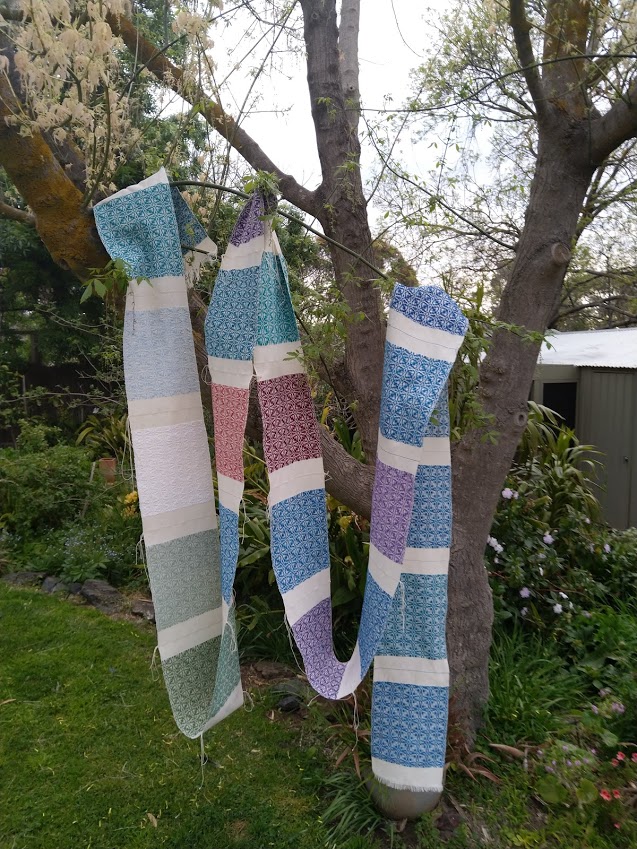 The actual project was an excellent idea to use up a donated stash of cottons and honour the memory of a former Guild member. Each participant would weave 20 (or was it 21?) squares in overshot, one for themself, one for everyone else and one for the Guild. Each would choose their own pattern in 4-shaft overshot and their own colours. You could either accept squares woven in other people’s colours, or wind off the weft for everyone to weave in your colour. The squares would then be exchanged at a meeting a few months down the track and each participant would sew their squares into a quilt. That’s what I hadn’t been aware of to start with. A quilt? Sew? Squares and straight lines? Too late to back out now…
The actual project was an excellent idea to use up a donated stash of cottons and honour the memory of a former Guild member. Each participant would weave 20 (or was it 21?) squares in overshot, one for themself, one for everyone else and one for the Guild. Each would choose their own pattern in 4-shaft overshot and their own colours. You could either accept squares woven in other people’s colours, or wind off the weft for everyone to weave in your colour. The squares would then be exchanged at a meeting a few months down the track and each participant would sew their squares into a quilt. That’s what I hadn’t been aware of to start with. A quilt? Sew? Squares and straight lines? Too late to back out now…
I didn’t get the weaving started until three weeks before the due date, and even then had  a long fight with the warp: three stands of very fine cotton that was as much fun as brushing the tangled hair of a squirming four-year-old. I’d never woven overshot either, but was no stranger to weaving with two shuttles, and at the rate of at least one square per evening, they were all finished in time. I chose the particular draft as it reminded me of nasturtium leaves, although as with most patterns, stare at it long enough and you start to see other things: keys, crosses, diamonds…
a long fight with the warp: three stands of very fine cotton that was as much fun as brushing the tangled hair of a squirming four-year-old. I’d never woven overshot either, but was no stranger to weaving with two shuttles, and at the rate of at least one square per evening, they were all finished in time. I chose the particular draft as it reminded me of nasturtium leaves, although as with most patterns, stare at it long enough and you start to see other things: keys, crosses, diamonds…
 Squares separated and exchanged, it was time to start sewing. Or thinking about it, buying batting, then more thinking… That process alone, together with buying fabric, thread and a walking foot for the sewing machine took another three months, then submitting for a group exhibition. I had asked that a sign be put next to mine declaring that I was a first-timer and had done woodwork and metalwork at school instead of sewing… and I wasn’t joking. At least it was displayed back-to-the-wall so that the bits of dodgy sewing (when the machine starts making noises and the fabric doesn’t move forward) weren’t visible. The edges are actually straight, contrary to how it was hanging at the time. Honest. First attempt, what can I say…
Squares separated and exchanged, it was time to start sewing. Or thinking about it, buying batting, then more thinking… That process alone, together with buying fabric, thread and a walking foot for the sewing machine took another three months, then submitting for a group exhibition. I had asked that a sign be put next to mine declaring that I was a first-timer and had done woodwork and metalwork at school instead of sewing… and I wasn’t joking. At least it was displayed back-to-the-wall so that the bits of dodgy sewing (when the machine starts making noises and the fabric doesn’t move forward) weren’t visible. The edges are actually straight, contrary to how it was hanging at the time. Honest. First attempt, what can I say…
A positive experience? Well, yes in that it took me out of my comfort zone, I got to know other weavers, and tried overshot for the first time and realised it could be used for colourful effects rather than simply making a pattern and limited shafts go further. Also there was the book that involved a workshop on making the covers; I couldn’t attend the second session on binding, but as there was a similar workshop last year, the work that went into it was appreciated.
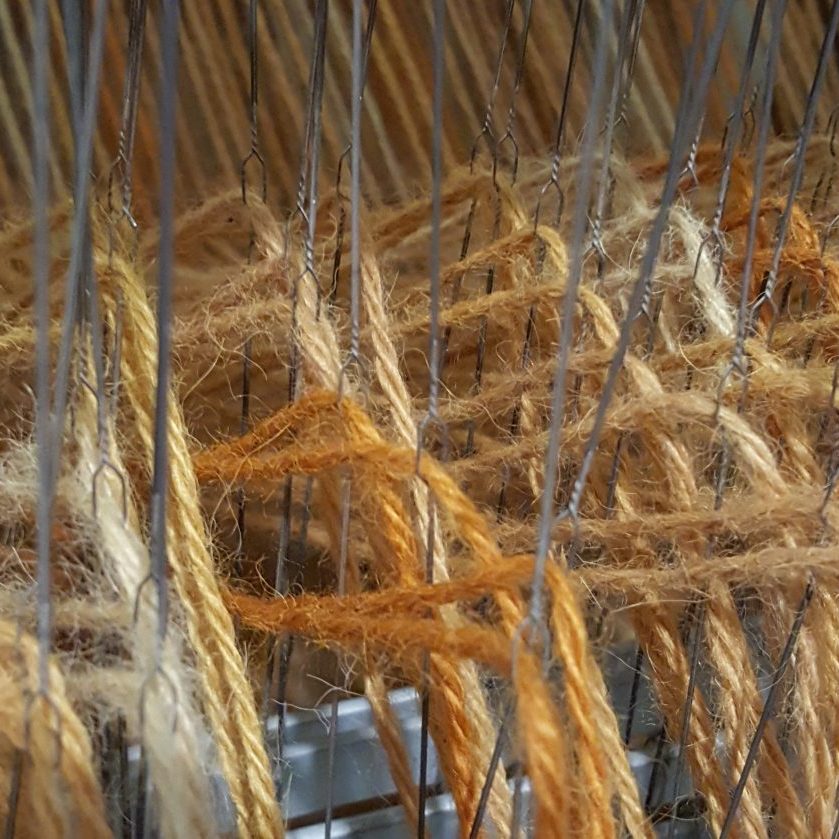


 The actual project was an excellent idea to use up a donated stash of cottons and honour the memory of a former Guild member. Each participant would weave 20 (or was it 21?) squares in overshot, one for themself, one for everyone else and one for the Guild. Each would choose their own pattern in 4-shaft overshot and their own colours. You could either accept squares woven in other people’s colours, or wind off the weft for everyone to weave in your colour. The squares would then be exchanged at a meeting a few months down the track and each participant would sew their squares into a quilt. That’s what I hadn’t been aware of to start with. A quilt? Sew? Squares and straight lines? Too late to back out now…
The actual project was an excellent idea to use up a donated stash of cottons and honour the memory of a former Guild member. Each participant would weave 20 (or was it 21?) squares in overshot, one for themself, one for everyone else and one for the Guild. Each would choose their own pattern in 4-shaft overshot and their own colours. You could either accept squares woven in other people’s colours, or wind off the weft for everyone to weave in your colour. The squares would then be exchanged at a meeting a few months down the track and each participant would sew their squares into a quilt. That’s what I hadn’t been aware of to start with. A quilt? Sew? Squares and straight lines? Too late to back out now… a long fight with the warp: three stands of very fine cotton that was as much fun as brushing the tangled hair of a squirming four-year-old. I’d never woven overshot either, but was no stranger to weaving with two shuttles, and at the rate of at least one square per evening, they were all finished in time. I chose the particular draft as it reminded me of nasturtium leaves, although as with most patterns, stare at it long enough and you start to see other things: keys, crosses, diamonds…
a long fight with the warp: three stands of very fine cotton that was as much fun as brushing the tangled hair of a squirming four-year-old. I’d never woven overshot either, but was no stranger to weaving with two shuttles, and at the rate of at least one square per evening, they were all finished in time. I chose the particular draft as it reminded me of nasturtium leaves, although as with most patterns, stare at it long enough and you start to see other things: keys, crosses, diamonds… Squares separated and exchanged, it was time to start sewing. Or thinking about it, buying batting, then more thinking… That process alone, together with buying fabric, thread and a walking foot for the sewing machine took another three months, then submitting for a group exhibition. I had asked that a sign be put next to mine declaring that I was a first-timer and had done woodwork and metalwork at school instead of sewing… and I wasn’t joking. At least it was displayed back-to-the-wall so that the bits of dodgy sewing (when the machine starts making noises and the fabric doesn’t move forward) weren’t visible. The edges are actually straight, contrary to how it was hanging at the time. Honest. First attempt, what can I say…
Squares separated and exchanged, it was time to start sewing. Or thinking about it, buying batting, then more thinking… That process alone, together with buying fabric, thread and a walking foot for the sewing machine took another three months, then submitting for a group exhibition. I had asked that a sign be put next to mine declaring that I was a first-timer and had done woodwork and metalwork at school instead of sewing… and I wasn’t joking. At least it was displayed back-to-the-wall so that the bits of dodgy sewing (when the machine starts making noises and the fabric doesn’t move forward) weren’t visible. The edges are actually straight, contrary to how it was hanging at the time. Honest. First attempt, what can I say… The photo shows just how well it turned out using two shades of brown and a red at half strength (all Landscape dyes). Several small samples of that experiment remain, but very little of the blue-grey yarn. The solution? Grey handspun?
The photo shows just how well it turned out using two shades of brown and a red at half strength (all Landscape dyes). Several small samples of that experiment remain, but very little of the blue-grey yarn. The solution? Grey handspun? The day began with a display table (photo used with permission) that was a true feast for the eyes: braids and straps in all colours and designs and even some balls of yarn in traditional colours. This reminded me of Nilda Callañaupa Alvarez on the Interweave dvd Andean Spinning talking about keeping balls of yarn until they were “hard”. Laverne showed us a warp set up using freshly-spun yarn; the threads were all spiralled around each other and didn’t want to sit straight. The “aged” yarn on the other hand was “hard” and as straight as can be.
The day began with a display table (photo used with permission) that was a true feast for the eyes: braids and straps in all colours and designs and even some balls of yarn in traditional colours. This reminded me of Nilda Callañaupa Alvarez on the Interweave dvd Andean Spinning talking about keeping balls of yarn until they were “hard”. Laverne showed us a warp set up using freshly-spun yarn; the threads were all spiralled around each other and didn’t want to sit straight. The “aged” yarn on the other hand was “hard” and as straight as can be. to take and finish at home as well as an introduction to various designs and techniques, and a thirst to practise everything and try out all the fascinating designs in Laverne’s books – we were able to purchase a couple of these as well as a dvd for the Guild library. Needless to say, there’s already a waiting list!
to take and finish at home as well as an introduction to various designs and techniques, and a thirst to practise everything and try out all the fascinating designs in Laverne’s books – we were able to purchase a couple of these as well as a dvd for the Guild library. Needless to say, there’s already a waiting list! . Most of the yarn was from a fleece in all shades from beige to chocolate, and no doubt from a crossbreed sheep and a beginner spinner; the yarn was spun unevenly and had clearly been done by the same method as my own – stick your hand into the bag and spin whatever comes out, rather than separating the fleece into colours and textures.
. Most of the yarn was from a fleece in all shades from beige to chocolate, and no doubt from a crossbreed sheep and a beginner spinner; the yarn was spun unevenly and had clearly been done by the same method as my own – stick your hand into the bag and spin whatever comes out, rather than separating the fleece into colours and textures.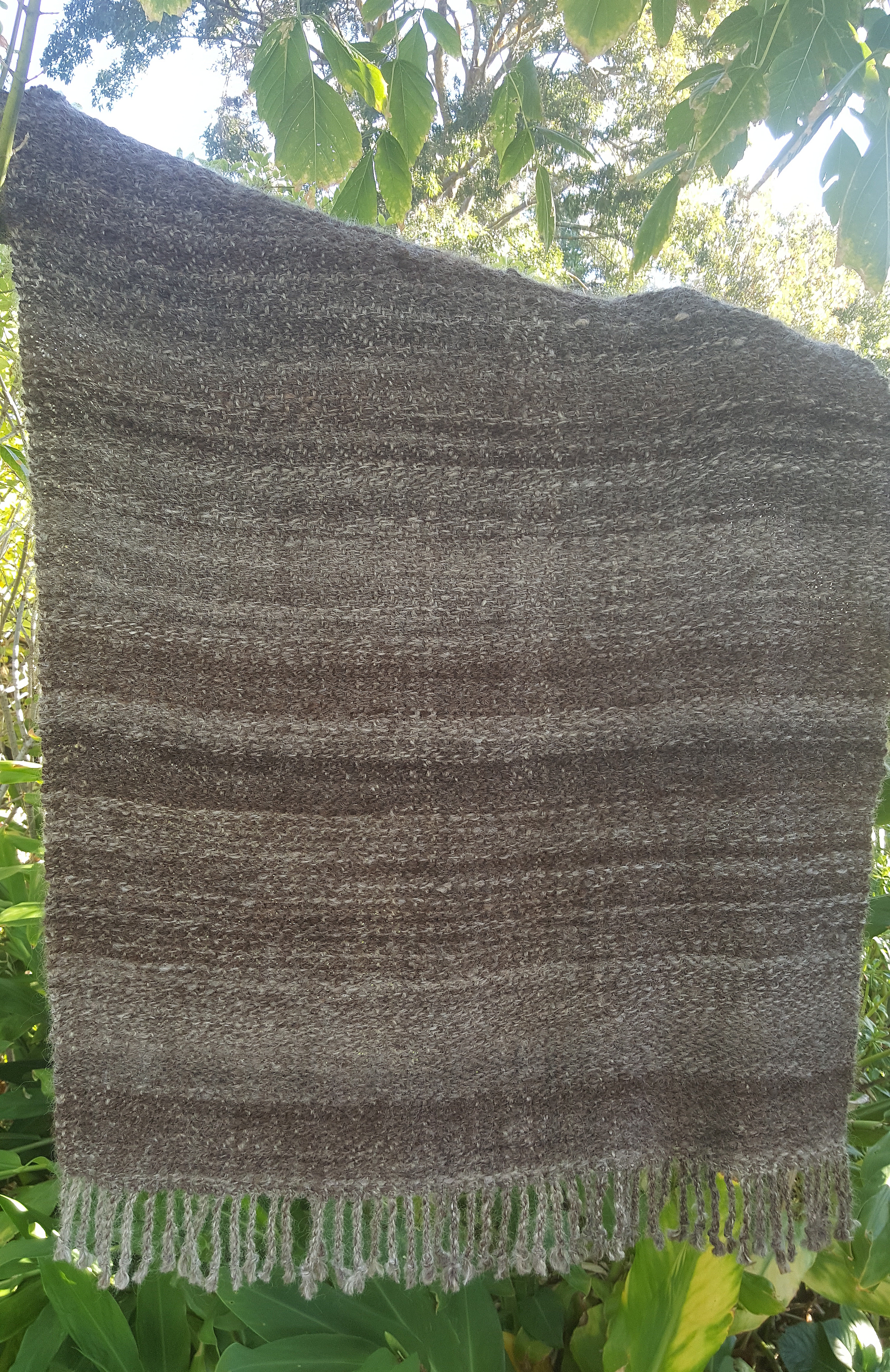 The yarn was singles, so this was plied double, with the resulting average wpi at around 8, so I chose a four-shaft, 3-1 twill at 6epi. At first this seemed as though it may have had to come down to 4 or 5 epi, but the finished item confirms 6 epi was right. The size was calculated at using most of the yarn, although after weaving most of the blanket, I decided that the last ball looked too felted compared with the rest and cut the project short. It had obvi
The yarn was singles, so this was plied double, with the resulting average wpi at around 8, so I chose a four-shaft, 3-1 twill at 6epi. At first this seemed as though it may have had to come down to 4 or 5 epi, but the finished item confirms 6 epi was right. The size was calculated at using most of the yarn, although after weaving most of the blanket, I decided that the last ball looked too felted compared with the rest and cut the project short. It had obvi ously come from the short-and-fuzzies of the fleece, while the rest was noticeably coarser and slicker.
ously come from the short-and-fuzzies of the fleece, while the rest was noticeably coarser and slicker.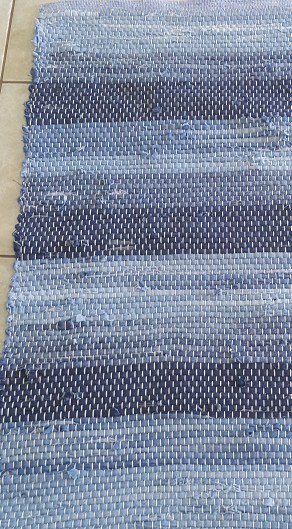 I’d made a couple of rag rugs some years ago and was amazed at i.) how much warp they required and ii.) how quickly they wove up. The first has become a foot mat under the loom pedals, whilst the second is stretched out in glorious tri-colour in the back room. This time the task was to get through the pile of old jeans and t-shirts that had grown to the right size for harvesting.
I’d made a couple of rag rugs some years ago and was amazed at i.) how much warp they required and ii.) how quickly they wove up. The first has become a foot mat under the loom pedals, whilst the second is stretched out in glorious tri-colour in the back room. This time the task was to get through the pile of old jeans and t-shirts that had grown to the right size for harvesting. One used 3 pairs of adult male jeans in large, the other 3 1/2 pairs (different sizes). The weft was cut into 1″ strips (more or less), and the binding was approximately half the width, cut from a linen shirt. Actually I have to admit that one of the large pairs was XXL. I’d run out of jeans and saw that they were only $7 new in one outlet, so naturally went for the biggest size I could get. Probably cheaper than an op shop, too.
One used 3 pairs of adult male jeans in large, the other 3 1/2 pairs (different sizes). The weft was cut into 1″ strips (more or less), and the binding was approximately half the width, cut from a linen shirt. Actually I have to admit that one of the large pairs was XXL. I’d run out of jeans and saw that they were only $7 new in one outlet, so naturally went for the biggest size I could get. Probably cheaper than an op shop, too. All the rugs are actually straighter than they appear in the photos (honest!), and after Mr Knisely’s comment on the DVD (you don’t need both DVD and book as they are in total accord) about never getting perfect edges because they’re rag rugs, I felt better.
All the rugs are actually straighter than they appear in the photos (honest!), and after Mr Knisely’s comment on the DVD (you don’t need both DVD and book as they are in total accord) about never getting perfect edges because they’re rag rugs, I felt better. stiffer both before and after laundering, the wibbly-wobbly effect is the same and the finished article has all the drape and comfort expected of tencel.
stiffer both before and after laundering, the wibbly-wobbly effect is the same and the finished article has all the drape and comfort expected of tencel.
 Having set the loom up for boxes some time ago, I wondered what I could weave using the same tie-up. Lazy? Perhaps, but it lead to something worthwhile…
Having set the loom up for boxes some time ago, I wondered what I could weave using the same tie-up. Lazy? Perhaps, but it lead to something worthwhile… more suited to a thicker yarn where the design would be more evident. Then one stood out form the rest… the moving boxes.
more suited to a thicker yarn where the design would be more evident. Then one stood out form the rest… the moving boxes.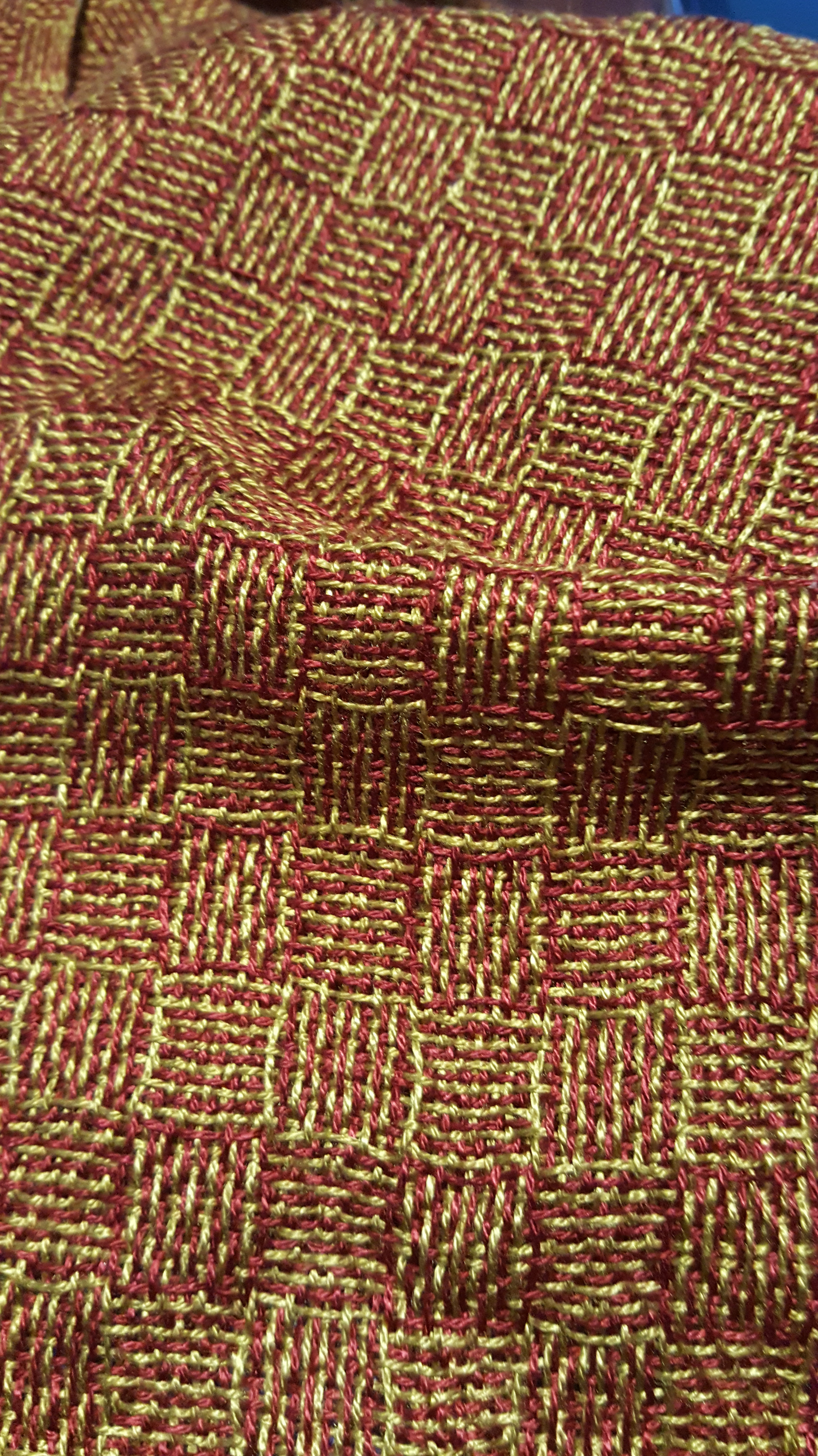 the loom and allowing the weaving to relax, the curves became irregular. Laundering at 40C in the front loader left the fabric soft and silky, and the boxes are permanently “moving”.
the loom and allowing the weaving to relax, the curves became irregular. Laundering at 40C in the front loader left the fabric soft and silky, and the boxes are permanently “moving”.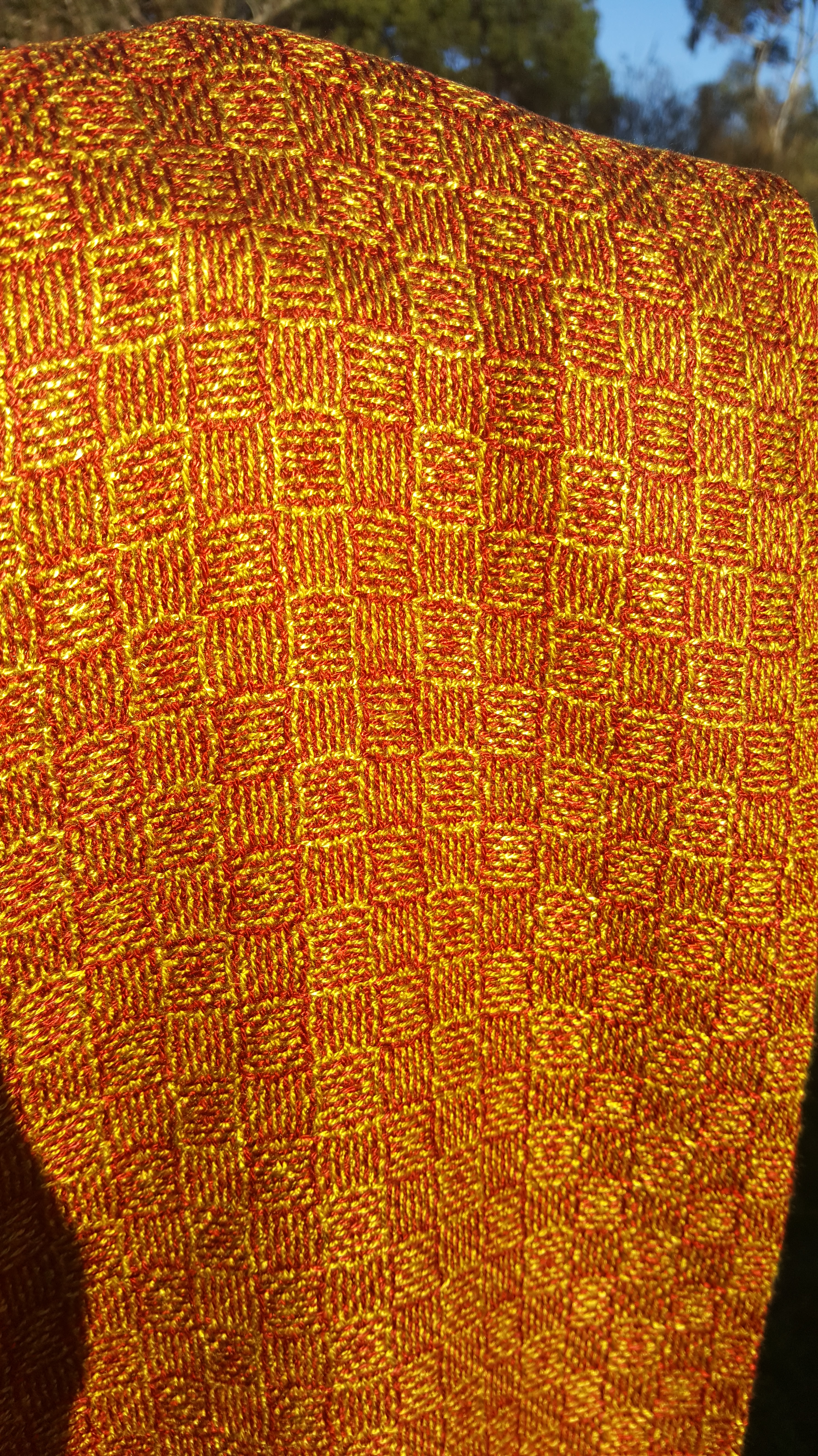 to be comfortable.
to be comfortable. Every now and again I’m lucky enough when a friend or colleague (or both) shows me something fibre- or craft-related that belonged to a relative, or was made by a relative. Fibre-crafts and social history, the perfect mix!
Every now and again I’m lucky enough when a friend or colleague (or both) shows me something fibre- or craft-related that belonged to a relative, or was made by a relative. Fibre-crafts and social history, the perfect mix! or catching the evening meal. All were at least eighty years old.
or catching the evening meal. All were at least eighty years old. but there was Alice, trying to make her way through the first door after drinking the potion that made her smaller. The floor had black and white tiles, chequer-board fashion, and because the floor was sloping, perspective made the tiles smaller in size the closer to the door they became.
but there was Alice, trying to make her way through the first door after drinking the potion that made her smaller. The floor had black and white tiles, chequer-board fashion, and because the floor was sloping, perspective made the tiles smaller in size the closer to the door they became.